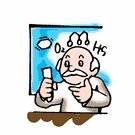
Worksheets and No Prep Teaching Resources
Reading Comprehension Worksheets
Science Process Skills

Science Process Skills
 Worksheets and No Prep Teaching Resources Reading Comprehension Worksheets Science Process Skills |
 Science Process Skills |
| edHelper's suggested reading level: | grades 5 to 7 | |
| Flesch-Kincaid grade level: | 9.01 |
|
Eye Identify!
By Trista L. Pollard |

|
 1 What blinks and is your own video screen in your head? Your eyes, of course, and they are one of the five tools you use for observing your environment. To scientists, observing is a major beginning step to the exploration of scientific questions. When you observe objects or events in your environment, you use your five senses to identify properties, notice changes, and recognize similarities and differences. Each sense helps you to focus on specific details about those objects and events.
1 What blinks and is your own video screen in your head? Your eyes, of course, and they are one of the five tools you use for observing your environment. To scientists, observing is a major beginning step to the exploration of scientific questions. When you observe objects or events in your environment, you use your five senses to identify properties, notice changes, and recognize similarities and differences. Each sense helps you to focus on specific details about those objects and events. |
Create Weekly Reading Books
Prepare for an entire week at once! |
| Leave your feedback on Eye Identify! (use this link if you found an error in the story) |
 |
Science Process Skills
|
 |
Science
|